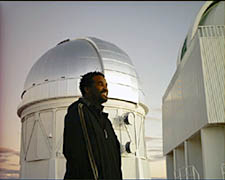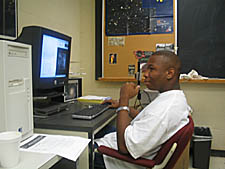Student Features
Leading the Way
08.04.05
| Who Are NASA's Space Science Explorers? Who are NASA's Space Science Explorers? The scientist studying black holes in distant galaxies. And the engineer working on robotic machines bound for space. But also the teacher explaining the mysteries of the cosmos. And the student wondering if there is life beyond Earth. All of these people are Space Science Explorers. They are all linked by their quest to explore our solar system and universe. This monthly series will introduce you to NASA Space Science Explorers, young and old, with many backgrounds and interests. Nominate a Space Science Explorer! Tell us about the Space Science Explorers you know. We're looking for students, teachers, scientists and others who have a connection to NASA, whether they work for the agency or are involved in a NASA-supported mission or program. Send your nominations to Dan Stillman: dan_stillman@strategies.org. |
Statistics do not always tell the whole story. These numbers, however, are pretty clear: African Americans, Hispanics and Native Americans make up more than 25 percent of the U.S. population. But they account for only three percent of those who earn a Ph.D. in astronomy. That is according to a recent survey.
 |
Thompson Le Blanc and Matthew Richardson are doing their part to change this trend. They are two of the first students to participate in the FASST program. FASST stands for the Fisk Astronomy and Space Science Training Program." Fisk and Vanderbilt universities run the program. Both schools are in Nashville.
The goal of FASST is to increase the number of minorities pursuing degrees and jobs in space science. The program helps graduate students pay for school. It also conducts workshops for teachers. And it reaches out to kids in grades K-12. FASST is funded by NASA and the National Science Foundation.
Le Blanc is both Hispanic and African-American. Right now, he is studying to get a master's in physics at Fisk. Once he succeeds, he will move on to Vanderbilt to get a Ph.D. in astronomy or another science. It is important to know physics well before trying for a Ph.D. in astronomy.
How did Le Blanc become interested in astronomy? It was pretty random how it happened. Le Blanc was born in Puerto Rico. He went to college at Metropolitan University in San Juan. One day he found an old telescope in a science lab there. He asked if he could use it, and before long he was hooked. He loved to look up at different constellations of stars.
Le Blanc is now in his second year at Fisk. He is already visited Chile to learn how to operate a large telescope. And he is deep into research. He is studying how young stars form, and how a star's spin is related to its surrounding gas and dust. Le Blanc is doing what some people said he could not.
"I have had experiences where I have had people tell me that I could not [be a scientist]," he said. "I guess in part the reason why I am in it now is because I want to prove that I can do it."
 |
Richardson is a sophomore at Fisk. He is also African-American and majoring in physics. And like Le Blanc, he has dived head first into astronomy research. His main task has been to examine star data. He is trying to learn more about changes in the brightness of stars. That is pretty good for someone who was not sure what he wanted to do when he came to Fisk last year.
"I just wanted to do something that involved science … and I chose physics. We were going over a lesson one day and one of the examples [the teacher] used was a star in space. It seemed very interesting … so I just figured that it would be a good field for me to try to explore," Richardson said.
Le Blanc and Richardson are not alone. There are more minorities who have the drive and talent to do well in space science than some people think. That is what Keivan Stassun says. He is one of the professors in charge of FASST. And he is a mentor for both Le Blanc and Richardson.
The problem, Stassun says, is that graduate programs do not pay enough attention to certain schools. He says they need to recruit more from schools like Fisk, schools that have a lot of talented minorities. Fisk is a historically black university. That means a large number of its students are African-American. "We need to recognize where the minority science students are," Stassun said.
FASST pays attention to younger students as well. It does this with the Fisk-Vanderbilt NASA Roadshow. The roadshow travels around to local schools and community groups. The highlight of the show is a portable planetarium. Inside, kids are treated to a virtual tour of the night sky. The idea is to get all kids excited about astronomy and space science.
What about those already thinking about a career in science? Le Blanc encourages them to ignore those who aim to discourage.
"If they want to get into the sciences, they should definitely go for it regardless of what anybody tells them," Le Blanc said. "Only oneself can know exactly what you can or cannot do. There should not be any limit put on by anybody else."
See previous Space Science Explorers articles:
+ View site
Related Resource
How Astronomers Use the Electromagnetic Spectrum
+ View site